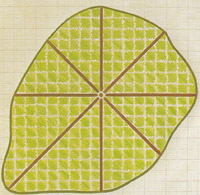
The skin that covers a tree – the bark – keeps the tree from drying out and helps to protect it against attack by animals and fungi. Bark may be thin and smooth, or thick and knobbly, depending on the type of tree and its age. Young trees usually have smooth bark on their trunks and brunches. Old bark stretches and cracks or peels, as the trunk grows wider year by year. Just underneath the bark is a delicate layer of tissue called a phloem. It carries nutrients from the leaves to all parts of the tree. If a bark is damaged all around the tree trunk, the flow of food stops and the tree dies.
The appearance of the bark can help you decide what species (type) a tree is. Different trees have different kinds of bark. A mature tree beech tree has smooth, thin bark that is about ½in deep. A redwood tree of the same size has hairy, fibrous bark that is up to 6in thick. Many conifers, such as pines and spruces, have bark that flakes off. Follow the first two projects and become a bark detective, by studying the bark up close and making a collection of your own bark rubbing. The third project will help you estimate the size of a tree.
Magnifying glass, field guide, notebook, pencil.
Paper, wax crayons, pencil, colored card, bradawl or hole puncher, ribbon, adhesive.
Compass, marker, yardstick, graph paper, ruler, colored pencils.
What you have 3 sketched and colored in shows the shape of the area covered by trees leaves and branches (the crown). Count the squares and half squares to find the size of the area of the crown. Do not count part-squares if they are less than a half. Each ½in square represents 1 yard. Compare with other trees in the area. Generally, the older the tree, the more likely it will have a large crown.

Looking for something? Ask Google.
Try out the other sections